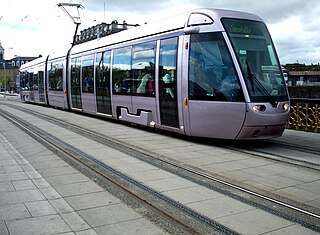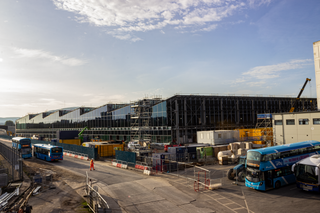Most of the transport system in Ireland is in public hands, either side of the Irish border. The Irish road network has evolved separately in the two jurisdictions into which Ireland is divided, while the Irish rail network was mostly created prior to the partition of Ireland.

Transport in the United Kingdom is highly facilitated by road, rail, air and water networks. Transport is a devolved matter with each of the countries of the United Kingdom having separate systems under separate governments.

NI Railways, also known as Northern Ireland Railways, is the railway operator in Northern Ireland. NIR is a subsidiary of Translink, whose parent company is the Northern Ireland Transport Holding Company (NITHCo), and is one of eight publicly owned train operators in the United Kingdom, the others being Direct Rail Services, Northern Trains, Transport for Wales Rail, Southeastern, LNER, ScotRail, and TransPennine Express. It has a common Board of Management with the other two companies in the group, Ulsterbus and Metro.

Translink is the brand name of the Northern Ireland Transport Holding Company (NITHCo), a public corporation in Northern Ireland which provides the public transport in the region. NI Railways, Ulsterbus and Metro are all part of Translink. It is led by CEO Chris Conway.

Ulsterbus is a public transport operator in Northern Ireland and operates bus services outside Belfast. It is part of Translink, the brand name for the subsidiary operating companies of the Northern Ireland Transport Holding Company, which also includes Northern Ireland Railways and Metro Belfast.
The Public Record Office of Northern Ireland (PRONI) is situated in Belfast, Northern Ireland. It is a division within the Engaged Communities Group of the Department for Communities (DfC).

The Odyssey Complex, consisting of Odyssey Place and the SSE Arena, is a sports, entertainment and science learning complex located within the Titanic Quarter in Belfast, Northern Ireland.

Metro is the trading name for bus company Citybus in Belfast, Northern Ireland. It is a subsidiary of the Northern Ireland Transport Holding Company, within the common management structure of Translink, along with Ulsterbus and Northern Ireland Railways.

The 98 B-Line was a bus rapid transit line in Metro Vancouver, British Columbia, Canada, that began service in September 2000. It linked Richmond to Downtown Vancouver, with a connection to Vancouver International Airport. It travelled mainly along Granville Street in Vancouver and a dedicated bus lane on No. 3 Road in Richmond. It was operated by Coast Mountain Bus Company and was funded by TransLink. The route was 16 kilometres (9.9 mi) long. The line carried over 18,000 passengers daily. It was discontinued in September 2009, shortly after the opening of the Canada Line, which replaced it.

The Belfast to Bangor line is a railway line in Northern Ireland, originally part of the Belfast & County Down Railway. All services are operated by NI Railways, the only operator for Northern Ireland (NI). Unlike the rest of the United Kingdom, no railway in NI is part of the National Rail network and none is owned by Network Rail. Services run every half-hour, with up to six trains per hour in each direction at peak times.
Translink is the public transit agency for Queensland, and is part of the Department of Transport and Main Roads. Translink was first introduced by the Queensland Government in June 2003 to orchestrate bus, ferry, rail and light rail services. They work with Brisbane Airtrain, Transport for Brisbane, RiverCity Ferries, Queensland Rail and other operators to provide services. Translink operates an integrated ticketing system across Queensland and the go card system to allow the use of one ticket on multiple services in South East Queensland.

Transport in Brisbane, the capital and largest city of Queensland, Australia, is provided by road, rail, river and bay ferries, footpaths, bike paths, sea and air.

Titanic Quarter in Belfast, Northern Ireland, is a large-scale waterfront regeneration, comprising historic maritime landmarks, film studios, education facilities, apartments, a riverside entertainment district, and the world's largest Titanic-themed attraction centred on land in Belfast Harbour, known until 1995 as Queen's Island. The 185-acre (75 ha) site, previously occupied by part of the Harland and Wolff shipyard, is named after the company's, and the city's, most famous product, RMS Titanic. Titanic Quarter is part of the Dublin-based group, Harcourt Developments, which has held the development rights since 2003.
EWAY is a bus rapid transit route being built in Northern Ireland to link the town of Dundonald in County Down with Belfast City Centre. If completed it will be about 5.5 miles (9 km) long.
Transportation systems in the city of Belfast, Northern Ireland, include road, air, rail, and sea. It is still a relatively car-dependent city; however, it is also served by a comprehensive rail and bus network. Belfast also ran electric trams prior to 1954. The city has two major airports, and the Port of Belfast is the busiest ferry port on the island of Ireland.
The Comber Greenway is a 7-mile (11 km) traffic-free section of the National Cycle Network that runs along the old Belfast-Comber railway line. The cycle path starts on Dee Street in east Belfast and finishes at Comber in County Down. As well as a cycling path, it is also popular with people on foot. The most recent addition to the route was in November 2008 when the final link between Old Dundonald Road/Comber Rd junction and Comber was opened. This added 1.6 miles (2.6 km) to the route. One section runs through a SLNCI-designated Wetland ecosystem.

Public transport in Ireland exists in many of the Ireland's urban areas and rural areas, and takes a number of forms. Bus transport is the main form of public transport and is common in all cities. The cities, Dublin, Belfast, Cork, Limerick and Galway all have their own suburban rail networks, although Dublin is the only to have its own tram line, in the form of the Luas. Ireland has a population of 5 million people.

In Queensland, Australia, public bus services are coordinated by the Queensland Government's Department of Transport and Main Roads and provided by over 1000 operators. The coordination of public bus transport generally falls under three schemes: Translink services, QConnect services and the remaining rural/regional school services. Some operators also provide entirely private bus services in Queensland which are not subject to the same route and ticketing regulation as the public route providers, or segments thereof, are.

Belfast Grand Central station is an under-construction railway station and bus station in the city centre of Belfast, Northern Ireland. It will replace Great Victoria Street railway station and the Europa Buscentre; it is being built next to them, in a new neighbourhood called Weaver's Cross. Grand Central is expected to open in Autumn 2024, several months after the old railway station closes.














